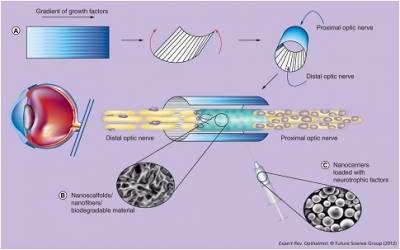Optic nerve injury is a consequence of numerous ophthalmic conditions including glaucoma, a leading cause of global blindness.
In adult humans, the optic nerve displays limited regenerative capacity, typical of neurons of the CNS.
In efforts to address this issue, a number of recent advances have been made in the identification of potential therapeutic targets that directly inhibit or stimulate optic nerve regeneration, with more work implicating several other factors.
These factors can be categorized as being intracellular or extracellular with respect to the neuron, or inflammatory cell-derived.
In addition to these therapeutic strategies, it is important to guide the regrowing axons to their correct destination.
Recent work has identified several developmental guidance factors important in regeneration, and potential therapeutic targets for the future.

A combination of various therapeutic strategies. (A) A nerve guidance conduit with a directional gradient of growth-promoting factors, and a topographical arrangement aiding directional growth of neurons. The conduit may be constructed into a planar structure that is subsequently rolled into a cylinder, or it may be constructed into a cylinder directly. (B) Diagramatic representation of nanoscaffolds (e.g., self-assembling peptide nanoscaffolds) forming a meshwork within the lesion to provide a medium for axons to grow across, aiding regeneration. (C) Nanocarriers carrying neurotrophic factors may be injected into the lesion to improve outcome. From Expert Review of Ophthalmology December 2012, Vol. 7, No. 6, Pages 533-554.
Cell-based therapies
Cell-based therapies are increasingly recognized as a potential strategy to treat retinal degenerative disease.
Their administration however, is normally indirect and complex.
Our group aims to develop a new approach to applying Schwann cells (SCs) directly to the optic nerve sheath (SC/DONS) in an in vivo glaucoma-related model, and to assess therapeutic effects on protection of retinal ganglion cells (RGCs) compared to SC intravitreal administration (SC/IVT), for treatment of optic neuropathies such as glaucoma.
 Close
Close

